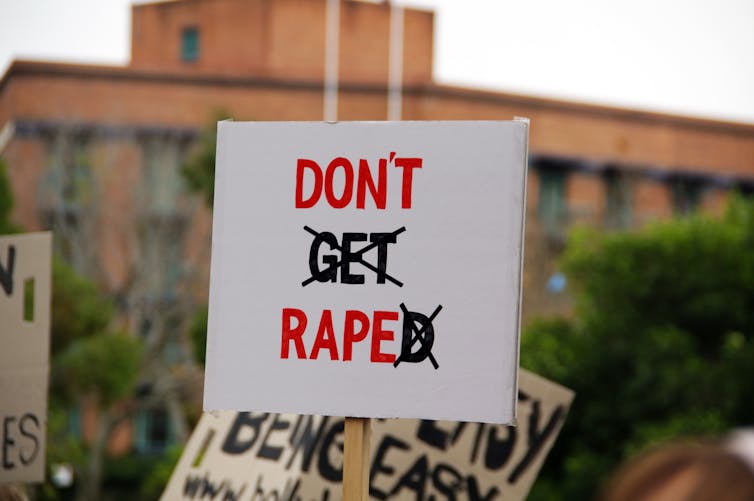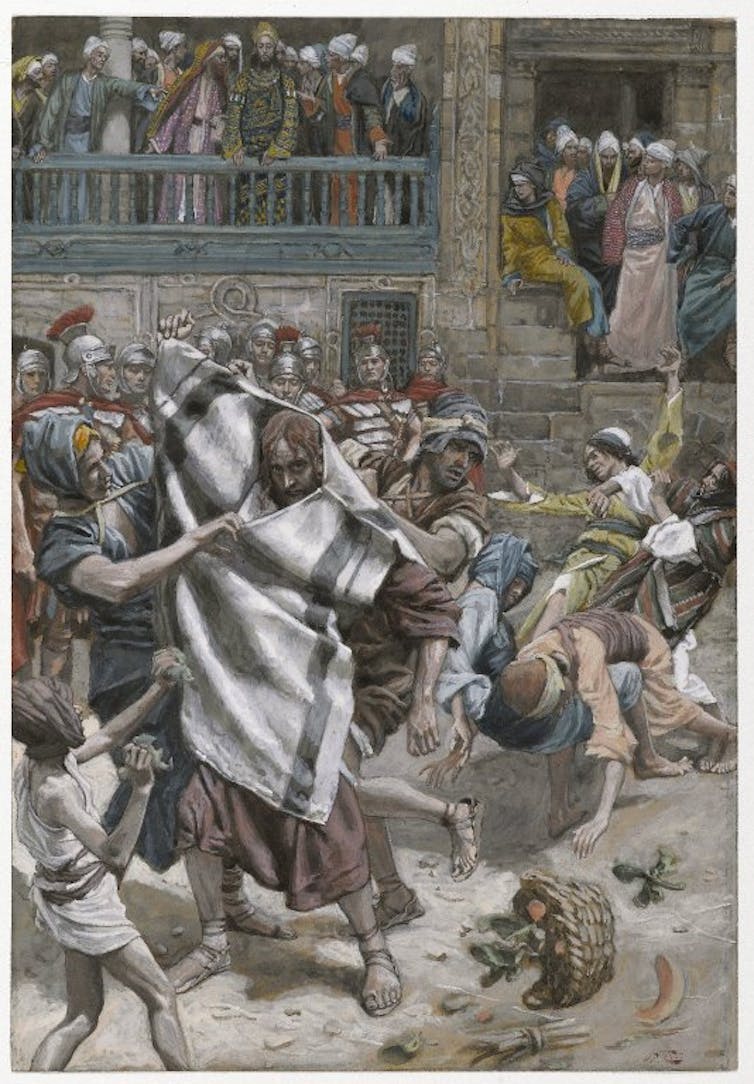Today’s post is by Rabbi Dr Deborah Kahn-Harris, Principal of Leo Baeck College in London, where she also lectures in Tanakh (Hebrew Bible), with a particular interest in the Megillot (the Scrolls, which comprise the books of Song of Songs, Ruth, Lamentations, Ecclesiastes and Esther). The book of Ruth is the second of the Megillot and widely celebrated as a women’s book and pastoral idyll. But how apt is this characterisation?
What does the book of Ruth have to do with rape culture? Surely the book of Ruth is little more than a rural idyll, a romantic novella, the slightest of short stories. Everyone in the story seems so kind to each other. It’s the stuff of rather old fashioned Hollywood films. [At least ones from 1961. You can watch the whole film, The Story of Ruth here.]
What could any of that have to do with rape?
Yet Wil Gafney writes about the book of Ruth precisely in the context of rape, where she points to the use of the Hebrew root n.ś.’ in Ruth 1:4. Reading this root in relation to its usage in Judges 21:23, Gafney writes that n.ś.’ should be translated in both of these situations as ‘rape marriage’. She also argues that Ruth’s relationship with Naomi amounts to ‘sexploitation’. Naomi, as a now childless and older widow, exploits Ruth’s youthful, fertile body alongside sexual stereotypes about foreign (Moabite) women in order to ensure fertility for Naomi’s clan and secure Naomi’s own wellbeing. Ruth is suffering from a version of Stockholm Syndrome, so enamored of her mother-in-law and without anywhere else to turn, that she is easy prey for Naomi. Ruth is a sexually exploited, trafficked woman, whose story has been dressed up as a romance by the majority (Israelite) culture, who benefit from her treatment.[1]
The first time I read Gafney’s article, I was stunned. How could this charming little story, which I’ve read for years both as part of my sacred scriptures and of the annual observance of the Jewish festival of Shavuot, be the same story that Gafney was describing? How had I missed these undertones to the story? Like Molly Ringwald recently commenting on watching The Breakfast Club with her daughter, I wondered how I could ever read this text alongside my own nearly teenage daughter again. What messages would I be imparting to her, let alone my students?
For years, I have taught the book of Ruth both as a message about hesed, the traditional way in which the story has been read in Jewish communities, and more excitingly, I thought, as a straight ally to the LGBTQi community, as a story that celebrates a positive role model of love between women in the Hebrew Bible. For years I have given out Rebecca Alpert’s and Celena Duncan’s work on lesbian and bisexual readings (respectively) of Ruth as required reading for my students training for the progressive rabbinate alongside an article by Hugh Pyper, which posits a homosexual Boaz.[2] All three have become firm favourites among my generally liberal-leaning trainee rabbis.
These articles, the stories they uncover in the text, were the ones I wanted to tell, to pass on to my children, my students, and my community. We are not the first humans in history to have found models of family life that fall outside the bounds of the nuclear family; why couldn’t Ruth’s story be one about a polyamorous family or a lesbian couple and their close gay male friend building a family together? In a time when liberal religious communities are working hard to be inclusive, that’s the story I’ve wanted to share.
But Gafney’s article unsettled me and, not only me, but my students as well. One student went so far as to suggest that Gafney should be ashamed of herself for writing her article. Largely my students have been highly resistant to Gafney’s reading, refusing to believe that n.ś.’ might actually mean ‘rape marriage’.
Yet not one of my students has ever turned up for class having done the philological work required to refute Gafney’s argument (which they are all more than capable of doing). They have returned time and again to Ruth’s declaration of commitment to Naomi in Ruth 1:16-17 as proof that the story depicts a relationship of mutual love, without ever asking themselves whether this passage is a dialogue or a monologue. They simply have not wanted to believe the possibilities that Gafney’s reading opens up.
Much of Gafney’s argument centres on questions of consent, beginning with her translation of the root n.ś.’, which has many meanings. But it’s only rarely used in relation to marriage. Aside from Ruth, the only other examples of n.ś.’ relating to marriage in the Hebrew Bible are in Judges, Ezra, Nehemiah, and 1 & 2 Chronicles.
The passage in Judges describes an act of abduction – the unmarried men of the tribe of Benjamin are instructed to go to a festival in Shiloh and when the women come out dancing, they are told to capture a woman and forcibly carry her off to marry. Rape-marriage seems like an accurate description of what is happening here. In Ezra and Nehemiah the root refers disparagingly to foreign women exclusively, but says nothing about whether the women were forced into marriage. Ezra and Nehemiah use the root pejoratively, but that doesn’t necessarily equal rape marriage. In Chronicles the root neither indicates rape nor does it seem pejorative. The linguistic evidence, therefore, for defining n.ś.’ as ‘rape marriage’ is mixed.
From a narrative perspective, Ruth 1: 4 is such a slight verse that there’s little to glean from it. In v. 3 Naomi’s husband dies and she is left with her two sons. In v. 4 the sons are married to Moabite women and remain in Moab for some ten years. In v. 6 both sons die and we learn only that Naomi is left without either sons or husband. The matter of whether Ruth or, indeed, Orpah consents to marriage with Machlon or Chilion is of no interest whatsoever in the Bible.
So does n.ś.’ mean rape marriage in Ruth 1:4 or not? Can we meaningfully judge whether Ruth is coerced into her marriage with Machlon? From the linguistic and narratalogical viewpoint, I think that at best we can say maybe, but the evidence is slight.
What about other issues of consent in the book of Ruth? Does Ruth have a meaningful choice about staying with Naomi when she returns to Bethlehem? Ruth’s speech in Ruth 1: 16-17 is evocative for many readers, but does it reflect an actual choice on Ruth’s part? For instance, does Ruth actually have a ‘mother’s home’ Ruth 1:8 to which to return? Does Ruth love Naomi and, if so, is that love reciprocated?
Each year I ask my students if the book of Ruth passes the Bechdel Test (originally for films). The rules of the Bechdel Test are as follows: ‘(1) it has to have at least two women in it, who (2) talk to each other, about (3) something besides a man.’ This test helps frame our discussion of Ruth and Naomi’s relationship with each other, particularly around the matter of reciprocity.
Looking at Ruth 1: 8-19, in Ruth 1:8-9 Naomi addresses both Ruth and Orpah. In v.10 Ruth and Orpah reply, followed by Naomi’s response in vv.11-13. But Naomi speaks of husbands, sons, and marriage (all in a strictly patriarchal, heteronormative fashion), thus failing to pass the Bechdel test. In v.15 Naomi, experiencing that Ruth continues to cling to her, simply encourages Ruth to return home. In vv.16-17 Ruth commits herself very vocally to remaining with Naomi. In vv.15-17 we find no mention of husbands, sons, or marriage, but can these verses really be seen outside the context of vv.8-14?
More tellingly, we also find no verbal reply from Naomi to Ruth’s speech. Verse 19 simply states that Ruth and Naomi went to Bethlehem together. Naomi’s silence following Ruth’s speech seems to imply that she consents to Ruth accompanying her, but it tells us nothing about whether she reciprocates Ruth’s feelings. The Bechdel Test was designed to assess whether female film characters have an independent life outside of their relationship to male characters. In asking whether Ruth loves Naomi and whether Naomi reciprocates, part of what we are asking is whether Ruth and Naomi are capable of having a relationship of any sort outside of the patriarchal and heteronormative society in which the story is set. Naomi’s silence in v. 19 is a yawning gap in the text, but we must at least consider that Naomi does not reciprocate Ruth’s feelings.
If that is the case, what are Naomi’s motivations in acquiescing to Ruth’s desire to return with her? Does Naomi prey on Ruth’s vulnerabilities to gain access to fertility, and hence, status for herself? Is Naomi trapped, too, by the constraints of a patriarchal society? Can she both genuinely care for Ruth and at the same time be guilty of exploiting Ruth’s fertility? What would that mean for Ruth’s consent? How much of Naomi’s motivations would Ruth know or fully understand? What could consent mean for either Ruth or Naomi in a situation where they are both so potentially restricted in their choices that choice has little meaning?
The text of the book of Ruth is concise. The questions I have asked are not easily answered, because the text provides us precious few clues to determine the motivation of the characters. We must infer much and what we infer will undoubtedly at least in part stem from the perspectives we bring with us as readers.
I have wanted Ruth to be a role model for the acceptance of difference in Jewish communities, because that is a cause close to my heart and my theology. Equally, I have no personal or direct experience of sex trafficking. I am conscious, therefore, that my reading of Ruth has been shaped by my own theological imperatives.
My discomfort with the idea of Ruth being a story of sexploitation and human trafficking is not because these themes are absent from Ruth, but because they do not fit the story that I have wanted to tell. Equally, these themes are not such an obvious or straightforward read from the text. They are present in the questions I have been asking and rely on the answers we give, which depend to some large extent on our own imaginations.
The meaning of n.ś.’ is not as clear cut as Gafney would have us believe, but nor is her reading impossible. The exact nature of the relationship between Ruth and Naomi is not easy to pin down, but instead multi-layered, intersectional, and ambiguous. Rather than either/or, it may and/and – both affection and abuse and both limited by the nature of biblical circumstances.
[1] Gafney, Wil 2009 ‘Mother Knows Best: Messianic Surrogacy and Sexploitation in Ruth’, in Mother Goose, Mother Jones, Mommie Dearest, Cheryl Kirk-Duggan and Tina Pippin (eds), Atlanta: SBL, pp. 23-36.
[2] Alpert, Rebecca 1996 ‘Finding our Past: A Lesbian Interpretation of the Book of Ruth’, in Reading Ruth: Contemporary Women Reclaim a Sacred Story, Judith A. Kates and Gail Twersky Reimer (eds), New York: Ballantine Books, pp. 91-96.
Ducan, Celena M. 2000 ‘The Book of Ruth: On Boundaries, Love, and Truth’, in Take Back the Word: A Queer Reading of the Bible, Robert E. Goss and Mona West (eds), Cleveland, Ohio: The Pilgrim Press, pp. 92-102.
Pyper, Hugh 2013 ‘Boaz Reawakened: Modelling Masculinity in the Book of Ruth’, in Interested Readers: Essays on the Hebrew Bible in Honor of David J. A. Clines, James K. Aitken, Jeremy M. S. Clines, and Christl M. Maier (eds), Atlanta: SBL, pp. 445-458.


































